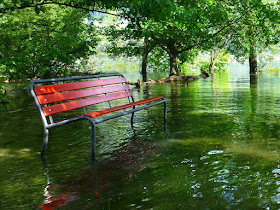The topic of this post may seem a little strange considering the previous article (scouting during low water periods), but observations made during those scouting trips can benefit times when fishing for bass along flooded shorelines as well.
Think about it for a moment … While scouting, you are not only observing exposed offshore structures on these scouting trips but you are also noting the “dry” shoreline conditions at the same time!
Getting Ready To Fish Flooded Shorelines …
Lakes and rivers often flood their shorelines, inundate adjacent real estate and the flood waters remain stable for several days, bass and other game fish often follow baitfish into this newly created aquatic realm. Knowing how the bass adjust then position themselves around new cover is the key to finding enough quality bass to make the trip worthwhile.
Depending on the nature of area where the flooding occurs and level of development adjacent to the water body, this new territory usually has a number of possible fish holding structures ranging from stands of bushes/trees, flooded fields with fence rows or other man-made items.
Quite often cover in the newly flooded area is so thick it appears bass could literally be anywhere! Identifying a specific bass fishing pattern (and not just cast to every piece of cover) to maximize your efforts is, to say the least, daunting.
One approach to address this dilemma; focus on isolated cover rather than try and hit each and every tree trunk in forest in the area you are fishing.
Tactics For Fishing Flooded Shorelines …
I remember fishing a tournament several years back when a series of exceptional spring storms combined with snow melt runoff causing the reservoir we were fishing to flood extensive areas of the shoreline. Timing was during the latter part of the spring and some bass were in all stages of the spawning cycle (pre-spawn, spawn and post spawn).
Most of the flooded areas covered extensive areas of brush. Fortunately we located a couple of coves where the brush was only present in scattered pods.
By focusing our efforts in the coves with scattered brush pods, we were able to locate decent concentrations of quality bass including one largemouth weighing 5 lbs. 13 oz.; the largest bass caught during the two-day tourney!
A few years earlier, another lake went into flood after heavy winter snows and a fast spring melt sent torrents of water discharging down mountain streams. Water entering the lake was frigid but warmed quickly once it rose and flooded the adjacent camping and picnic areas.
Even though there were extensive stands of flooded brush and trees, the areas with the scattered picnic shelters again held both the greatest numbers of quality bass.
So the next time you are fishing for bass along flooded shorelines or backwaters, remember that sometimes it is alright to be a little “scattered” in your approach!


No comments:
Post a Comment